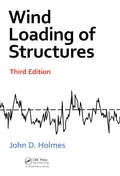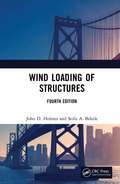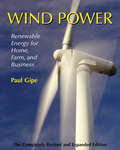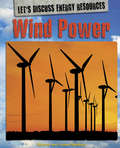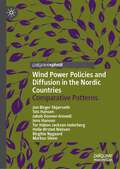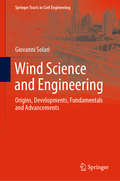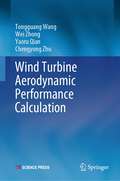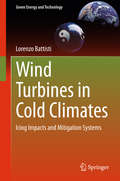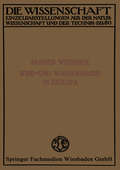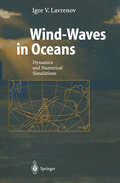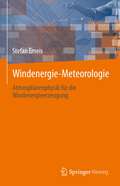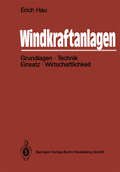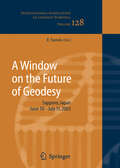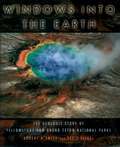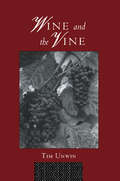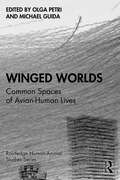- Table View
- List View
Wind Loading of Structures
by John D. HolmesA Definitive Up-to-Date Reference Wind forces from various types of extreme wind events continue to generate ever-increasing damage to buildings and other structures. Wind Loading of Structures, Third Edition fills an important gap as an information source for practicing and academic engineers alike, explaining the principles of wind loads on structures, including the relevant aspects of meteorology, bluff-body aerodynamics, probability and statistics, and structural dynamics. Written in Line with International Standards Among the unique features of the book are its broad view of the major international codes and standards, and information on the extreme wind climates of a large number of countries of the world. It is directed towards practicing (particularly structural) engineers, and academics and graduate students. The main changes from the earlier editions are: Discussion of potential global warming effects on extreme events More discussion of tornados and tornado-generated damage A rational approach to gust durations for structural design Expanded considerations of wind-induced fatigue damage Consideration of aeolian vibrations of suspended transmission lines Expansion of the sections on the cross-wind response of tall slender structures Simplified approaches to wind loads on "porous" industrial, mining, and oil/gas structures A more general discussion of formats in wind codes and standards Not dedicated to a specific code or standard, Wind Loading of Structures, Third Edition highlights the general format and procedures related to all major codes and standards, addresses structures of various types, and presents you with topics not typically covered in traditional texts such as internal pressures, fatigue damage by wind forces, and equivalent static wind load distributions.
Wind Loading of Structures
by John D. Holmes Seifu BekeleWind forces from extreme wind events are the dominant loading for many parts of the world, exacerbated by climate change and the continued construction of tall buildings and structures. This authoritative source, for practising and academic structural engineers and graduate students, ties the principles of wind loads on structures to the relevant aspects of meteorology, bluff-body aerodynamics, probability and statistics, and structural dynamics. This new edition covers: Climate change effects on extreme winds – particularly those from tropical cyclones, hurricanes, and typhoons Modelling of potential wind vulnerability and damage Developments in extreme value probability analysis of extreme windspeeds and directions Explanation of the difference between ‘return period’ and ‘average recurrence interval’, as well as ‘bootstrapping’ techniques for deriving confidence limits Wind over water, and profiles and turbulence in non-synoptic winds An expanded chapter on internal pressures produced by wind for various opening and permeability scenarios Aerodynamic shaping of high- and low-rise buildings Recent developments in five major wind codes and standards A new chapter on computational fluid dynamics (CFD), as applied to wind engineering A greatly expanded appendix providing basic information on extreme wind climates for over 140 countries and territories. Additional examples for many chapters in the book
Wind Loading of Structures
by John D. Holmes Seifu BekeleWind forces from extreme wind events are the dominant loading for many parts of the world, exacerbated by climate change and the continued construction of tall buildings and structures. This authoritative source, for practising and academic structural engineers and graduate students, ties the principles of wind loads on structures to the relevant aspects of meteorology, bluff-body aerodynamics, probability and statistics, and structural dynamics. This new edition covers: Climate change effects on extreme winds – particularly those from tropical cyclones, hurricanes, and typhoons Modelling of potential wind vulnerability and damage Developments in extreme value probability analysis of extreme windspeeds and directions Explanation of the difference between ‘return period’ and ‘average recurrence interval’, as well as ‘bootstrapping’ techniques for deriving confidence limits Wind over water, and profiles and turbulence in non-synoptic winds An expanded chapter on internal pressures produced by wind for various opening and permeability scenarios Aerodynamic shaping of high- and low-rise buildings Recent developments in five major wind codes and standards A new chapter on computational fluid dynamics (CFD), as applied to wind engineering A greatly expanded appendix providing basic information on extreme wind climates for over 140 countries and territories. Additional examples for many chapters in the book
Wind Power: Renewable Energy for Home, Farm, and Business, 2nd Edition
by Paul GipeIn the wake of mass blackouts and energy crises, wind power remains a largely untapped resource of renewable energy. It is a booming worldwide industry whose technology, under the collective wing of aficionados like author Paul Gipe, is coming of age. Wind Power guides us through the emergent, sometimes daunting discourse on wind technology, giving frank explanations of how to use wind technology wisely and sound advice on how to avoid common mistakes. Since the mid-1970s, Paul Gipe has played a part in nearly every aspect of wind energy’s development—from installing small turbines to promoting wind energy worldwide. As an American proponent of renewable energy, Gipe has earned the acclaim and respect of European energy specialists for years, but his arguments have often fallen on deaf ears at home. Today, the topic of wind power is cropping up everywhere from the beaches of Cape Cod to the Oregon-Washington border, and one wind turbine is capable of producing enough electricity per year to run 200 average American households. Now, Paul Gipe is back to shed light on this increasingly important energy source with a revised edition of Wind Power. Over the course of his career, Paul Gipe has been a proponent, participant, observer, and critic of the wind industry. His experience with wind has given rise to two previous books on the subject, Wind Energy Basics and Wind Power for Home and Business, which have sold over 50,000 copies. Wind Power for Home and Business has become a staple for both homeowners and professionals interested in the subject, and now, with energy prices soaring, interest in wind power is hitting an all-time high. With chapters on output and economics, Wind Power discloses how much you can expect from each method of wind technology, both in terms of energy and financial savings. The book’s updated models, graphics, and weighty appendixes make it an invaluable reference for everyone interested in the emerging trend of wind power and renewable energy. Executive Director of the American Wind Energy Association Randall Swisher has said, "In the last two decades, no one has done more that Paul Gipe to bring wind energy to the public’s attention."
Wind Power: Wind Power Library Ebook (Let's Discuss Energy Resources #1)
by Richard Spilsbury Louise SpilsburyWith supplies of non-renewable energy sources running low and the threat of global warming and climate change, there is an urgent need to look at other types of energy resources and how well they can meet our power needs. While new technologies are being developed, each energy resource comes at a cost. This series looks at each energy resource, the technology and cost of how it is used to meet power needs and how it impacts the environment and humans. Each book explains how that power is generated and where it is used, and then, using specific Let's Discuss panels, explores the various advantages and disadvantages that concern it's use as an alternative fuel source. Case studies examine specific usage examples where that source has either worked or not worked so that the reader can weigh up the pros and cons for the use of each source against the alternatives.
Wind Power Policies and Diffusion in the Nordic Countries: Comparative Patterns
by Jon Birger Skjærseth Teis Hansen Jakob Donner-Amnell Jens Hanson Helle Ørsted Nielsen Birgitte Nygaard Markus Steen Tor Håkon InderbergThis book focuses specifically on policy mixes and wind power diffusion in four Nordic countries – Denmark, Finland, Norway and Sweden. Although these Nordic welfare states have much in common, they have adopted different wind power policies and experienced dissimilar diffusion trajectories. Understanding these patterns across the Nordic countries is the central puzzle that this book investigates. Empirically, this book provides a first-of-its-kind comparative study of wind power policies in the Nordic countries. Analytically, the authors contribute to the transition policy mix literature, which remains largely insensitive to political feasibility. This book will be of interest to researchers and students as well as private and public decision makers looking for tools to enable the energy transition.
Wind Science and Engineering: Origins, Developments, Fundamentals and Advancements (Springer Tracts in Civil Engineering)
by Giovanni SolariThis book provides an essential overview of wind science and engineering, taking readers on a journey through the origins, developments, fundamentals, recent advancements and latest trends in this broad field. Along the way, it addresses a diverse range of topics, including: atmospheric physics; meteorology; micrometeorology; climatology; the aerodynamics of buildings, aircraft, sailing boats, road vehicles and trains; wind energy; atmospheric pollution; soil erosion; snow drift, windbreaks and crops; bioclimatic city-planning and architecture; wind actions and effects on structures; and wind hazards, vulnerability and risk. In order to provide a comprehensive overview of wind and its manifold effects, the book combines scientific, descriptive and narrative chapters. The book is chiefly intended for students and lecturers, for those who want to learn about the genesis and evolution of this topic, and for the multitude of scholars whose work involves the wind.
Wind Speed and Direction Symbol (tactile)
by Sheffield Vi ServiceThis is an image of the meteorological symbol for wind speed and direction. The wind speed is shown in the circle at the centre of the page.
Wind Turbine Aerodynamic Performance Calculation
by Tongguang Wang Wei Zhong Yaoru Qian Chengyong ZhuThis book deals with horizontal-axis wind turbine aerodynamic performance prediction methods. It focuses on the traditional and newly-developed methods for the wind turbine aerodynamic performance calculation. The fundamental theories of fluid mechanics essential for understanding the other parts of this book are firstly introduced in Part I, followed by the blade element momentum theory in Part II, with special attentions to a systematic review of various correction models. Part III is mainly about the prescribed and free vortex wake methods, while the state-of-art computational fluid dynamics (CFD) methods are detailed in Part IV.Part III thoroughly describes the prescribed and free vortex wake methods which are still of great importance towards realistic investigation of wind turbine performance. Despite the highly computational cost, the CFD methods in Part IV have received increasing interest from the academic community since they provide more detailed information about the flow field around the wind turbine. This has shed a light in combination with the correction models introduced in Part II on more advanced research for wind turbine.This book is intended for researchers and students interested in aerodynamics of wind turbine and is particularly suitable for practicing engineers in wind energy. Readers can gain a comprehensive understanding in both classical and up-to-date methods for the study of wind turbine aerodynamics. The authors hope that this book can promote the research and development of wind turbines.
Wind Turbines in Cold Climates: Icing Impacts and Mitigation Systems (Green Energy and Technology)
by Lorenzo BattistiThis book addresses the key concerns regarding the operation of wind turbines in cold climates and focuses in particular on the analysis of icing and methods for its mitigation. Topics covered include the implications of cold climates for wind turbine design and operation, the relevance of icing for wind turbines, the icing process itself, ice prevention systems and thermal anti-icing system design. In each chapter, care is taken to build systematically on the basic knowledge, providing the reader with the level of detail required for a thorough understanding. An important feature is the inclusion of several original analytical and numerical models for ready computation of icing impacts and design assessment. The breadth of the coverage and the in-depth scientific analysis, with calculations and worked examples relating to both fluid dynamics and thermodynamics, ensure that the book will serve not only as a textbook but also as a practical manual for general design tasks.
Wind- und Wasserhosen in Europa (Die Wissenschaft)
by Alfred WegenerDieser Buchtitel ist Teil des Digitalisierungsprojekts Springer Book Archives mit Publikationen, die seit den Anfängen des Verlags von 1842 erschienen sind. Der Verlag stellt mit diesem Archiv Quellen für die historische wie auch die disziplingeschichtliche Forschung zur Verfügung, die jeweils im historischen Kontext betrachtet werden müssen. Dieser Titel erschien in der Zeit vor 1945 und wird daher in seiner zeittypischen politisch-ideologischen Ausrichtung vom Verlag nicht beworben.
Wind-Waves in Oceans: Dynamics and Numerical Simulations (Physics of Earth and Space Environments)
by Igor LavrenovThe study of sea waves has always been in the focus of mankind's atten tion. This is attributed not only to a desire to understand the behaviour in seas and oceans, but also, it has some practical necessity. Developing up-to date wind wave numerical methods requires detailed mathematical modelling, starting with wave generation, development, propagation and transformation on the surface in different water areas under quasi-stationary conditions, up to a synthesis of climatic features observed under different wave generation conditions in oceans, sea or coastal areas. The present monograph considers wind waves in terms of the most general formulation of the problem as a probable hydrodynamic process with wide spatial variability. It ranges between the global scale of the oceans, whose typical size is comparable with the Earth's radius, to the regional and local scales of the seas, including water areas limited in space with significant current or depth gradients in coastal zones, where waves cease their existence having propagated tens of thousand miles.
Wind Weathering (large print)
by RnibThis page shows an image of a rock formation. There is a locator dot shown, which will be at the top left when the image is the correct way up. The image is surrounded by an image border. The ground goes from the left to the right at the bottom of the page. It is in three layers. There is a rock in the centre of the page which sits on the ground and goes up to the top centre of the page. It has lots of layers. The wind has picked particles of sand up and blasted them against this rock eroding it and creating this strange shape. The softer layers of rock have been eroded more than the harder layers.
Wind Weathering (UEB contracted)
by RnibThis page shows an image of a rock formation. There is a locator dot shown, which will be at the top left when the image is the correct way up. The image is surrounded by an image border. The ground goes from the left to the right at the bottom of the page. It is in three layers. There is a rock in the centre of the page which sits on the ground and goes up to the top centre of the page. It has lots of layers. The wind has picked particles of sand up and blasted them against this rock eroding it and creating this strange shape. The softer layers of rock have been eroded more than the harder layers.
Wind Weathering (UEB uncontracted)
by RnibThis page shows an image of a rock formation. There is a locator dot shown, which will be at the top left when the image is the correct way up. The image is surrounded by an image border. The ground goes from the left to the right at the bottom of the page. It is in three layers. There is a rock in the centre of the page which sits on the ground and goes up to the top centre of the page. It has lots of layers. The wind has picked particles of sand up and blasted them against this rock eroding it and creating this strange shape. The softer layers of rock have been eroded more than the harder layers.
Windenergie Meteorologie: Atmosphärenphysik für die Windenergieerzeugung
by Stefan EmeisDieses Buch bietet eine Einführung in die meteorologischen Randbedingungen für die Stromerzeugung aus Wind - sowohl an Land als auch auf See - und liefert meteorologische Informationen für die Planung und den Betrieb dieser wichtigen erneuerbaren Energiequelle. Es umfasst die Herleitung von Windgesetzen und Beschreibungen von Windprofilen, insbesondere oberhalb der logarithmischen bodennahen Schicht, und behandelt Winde über komplexem Gelände und nächtliche Low-Level-Jets. Diese aktualisierte und erweiterte zweite Auflage enthält neue Kapitel, die sich mit der Effizienz großer Windparks und deren Nachläufen sowie mit der Offshore-Windenergie befassen.
Windkraftanlagen: Grundlagen, Technik, Einsatz, Wirtschaftlichkeit
by Erich HauIn diesem Handbuch wird die Technologie moderner Windkraftanlagen systematisch und umfassend dargestellt. Ausgehend von den historischen Wurzeln der Windkraftnutzung führt der Autor über die technisch-physikalischen Grundlagen, den konstruktiven Aufbau, die Einsatzkonzeptionen und die Umweltverträglichkeit bis hin zu Wirtschaftlichkeitsuntersuchungen der Stromerzeugung mit Windenergie. Erstmalig wird eine fundierte Analyse der Herstellkosten moderner Windkraftanlagen gegeben und - darauf aufbauend - die Hauptfrage untersucht, unter welchen Bedingungen man mit dieser besonders umweltfreundlichen Energie wirtschaftlich Strom erzeugen kann. Hierbei werden Investitions- und Betriebskosten genau so berücksichtigt wie die Amortisation dieser modernen Technologie und deren Bedeutung im gesamtwirtschaftlichen Rahmen einer hochentwickelten Industriegesellschaft.
A Window on the Future of Geodesy: Proceedings of the International Association of Geodesy. IAG General Assembly, Sapporo, Japan June 30 - July 11, 2003 (International Association of Geodesy Symposia #128)
by Fernando SansòThese proceedings represent the worldwide picture of the state of the art of geodesy. The volume comprehensively covers the most recent results and supplies a good review of the new ideas developing in the field, opening a window to the future of geodesy.
Windows into the Earth: The Geologic Story of Yellowstone and Grand Teton National Parks
by Robert B. Smith Lee J. SiegelMillions of years ago, the North American continent was dragged over the world's largest continental hotspot, a huge column of hot and molten rock rising from the Earth's interior that traced a 50-mile wide, 500-mile-long path northeastward across Idaho. Generating cataclysmic volcanic eruptions and large earthquakes, the hotspot helped lift the Yellowstone Plateau to more than 7,000 feet and pushed the northern Rockies to new heights, forming unusually large glaciers to carve the landscape. It also created the jewel of the U.S. national park system: Yellowstone. Meanwhile, forces stretching apart the western U.S. created the mountainous glory of Grand Teton National Park. These two parks, with their majestic mountains, dazzling geysers, and picturesque hot springs, are windows into the Earth's interior, revealing the violent power of the dynamic processes within. Smith and Siegel offer expert guidance through this awe-inspiring terrain, bringing to life the grandeur of these geologic phenomena as they reveal the forces that have shaped--and continue to shape--the greater Yellowstone-Teton region. Over seventy illustrations--including fifty-two in full color--illuminate the breathtaking beauty of the landscape, while two final chapters provide driving tours of the parks to help visitors enjoy and understand the regions wonders. Fascinating and informative, this book affords us a striking new perspective on Earth's creative forces.
Windows into the Earth: The Geologic Story of Yellowstone and Grand Teton National Parks
by Robert B. Smith Lee J. SiegelMillions of years ago, the North American continent was dragged over the world's largest continental hotspot, a huge column of hot and molten rock rising from the Earth's interior that traced a 50-mile wide, 500-mile-long path northeastward across Idaho. Generating cataclysmic volcanic eruptions and large earthquakes, the hotspot helped lift the Yellowstone Plateau to more than 7,000 feet and pushed the northern Rockies to new heights, forming unusually large glaciers to carve the landscape. It also created the jewel of the U.S. national park system: Yellowstone. Meanwhile, forces stretching apart the western U.S. created the mountainous glory of Grand Teton National Park. These two parks, with their majestic mountains, dazzling geysers, and picturesque hot springs, are windows into the Earth's interior, revealing the violent power of the dynamic processes within. Smith and Siegel offer expert guidance through this awe-inspiring terrain, bringing to life the grandeur of these geologic phenomena as they reveal the forces that have shaped--and continue to shape--the greater Yellowstone-Teton region. Over seventy illustrations--including fifty-two in full color--illuminate the breathtaking beauty of the landscape, while two final chapters provide driving tours of the parks to help visitors enjoy and understand the regions wonders. Fascinating and informative, this book affords us a striking new perspective on Earth's creative forces.
Wine and the Vine: An Historical Geography of Viticulture and the Wine Trade
by Tim UnwinVery few books have products as diverse as those of the grape vine: even fewer have products with such a cultural significance. Wine and the Vine provides an introduction to the historical geography of viticulture and the wine trade from prehistory to the present. It considers wine as both a unique expression of the interaction of people in a particular environment, rich in symbol and meaning, and a commercial product of great economic importance to particular regions.
Wine and the Vine: An Historical Geography of Viticulture and the Wine Trade
by Tim UnwinVery few books have products as diverse as those of the grape vine: even fewer have products with such a cultural significance. Wine and the Vine provides an introduction to the historical geography of viticulture and the wine trade from prehistory to the present. It considers wine as both a unique expression of the interaction of people in a particular environment, rich in symbol and meaning, and a commercial product of great economic importance to particular regions.
Winged Worlds: Common Spaces of Avian-Human Lives (Routledge Human-Animal Studies Series)
by Olga Petri Michael GuidaThis edited collection explores our often-surprising modes of co-inhabiting the cultural and aerial worlds of birds. It focuses on our encounters with non-captive birds and the cultural geographies of feathered flight. This book offers a timely contribution to the more-than-human geographies of flight, space and territory. The chapters support an ethics of attention as a new basis for the conservation and cultivation of aerial habitats. Contributions adopt an interdisciplinary approach to the patterns of intrusion and escape that shape our encounters with birds and unsettle our traditionally terrestrial concepts of space. Each chapter focuses on a different aspect of our shared lives with birds, ranging from scientific observation to the social media-enabled spectacle of co-habitation and spatial competition.Written in a thought-provoking style, this book seeks to address a dearth of critical perspectives on the cultural geographies of flight and its implications for the ways in which we understand common spaces around and above us in the context of any effort at conservation.
Winged Worlds: Common Spaces of Avian-Human Lives (Routledge Human-Animal Studies Series)
by Olga Petri Michael GuidaThis edited collection explores our often-surprising modes of co-inhabiting the cultural and aerial worlds of birds. It focuses on our encounters with non-captive birds and the cultural geographies of feathered flight. This book offers a timely contribution to the more-than-human geographies of flight, space and territory. The chapters support an ethics of attention as a new basis for the conservation and cultivation of aerial habitats. Contributions adopt an interdisciplinary approach to the patterns of intrusion and escape that shape our encounters with birds and unsettle our traditionally terrestrial concepts of space. Each chapter focuses on a different aspect of our shared lives with birds, ranging from scientific observation to the social media-enabled spectacle of co-habitation and spatial competition.Written in a thought-provoking style, this book seeks to address a dearth of critical perspectives on the cultural geographies of flight and its implications for the ways in which we understand common spaces around and above us in the context of any effort at conservation.
Winners And Losers
by Chris HamnettFirst published in 1998. Routledge is an imprint of Taylor & Francis, an informa company.
